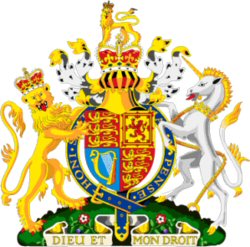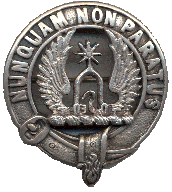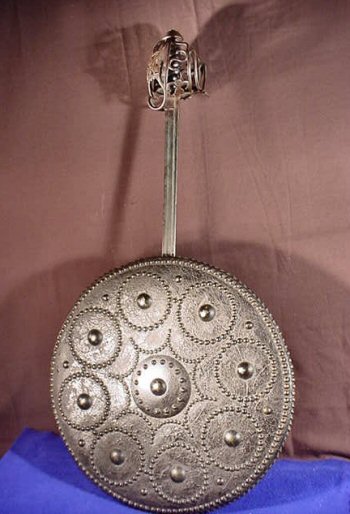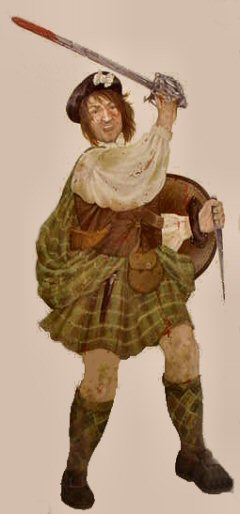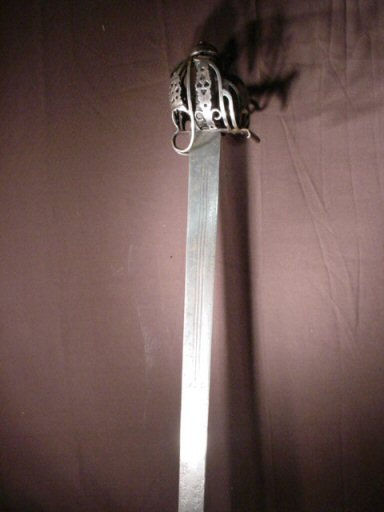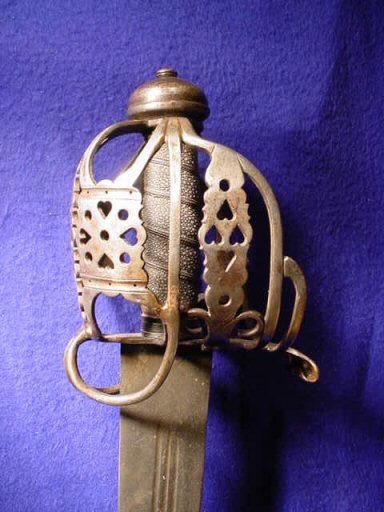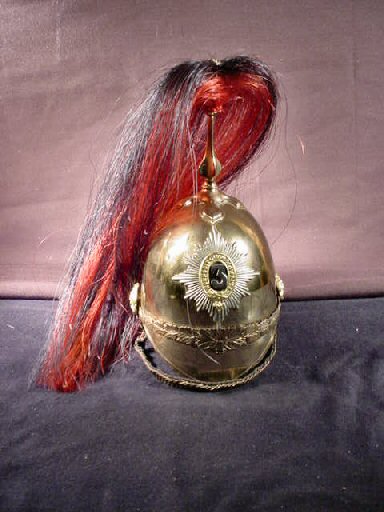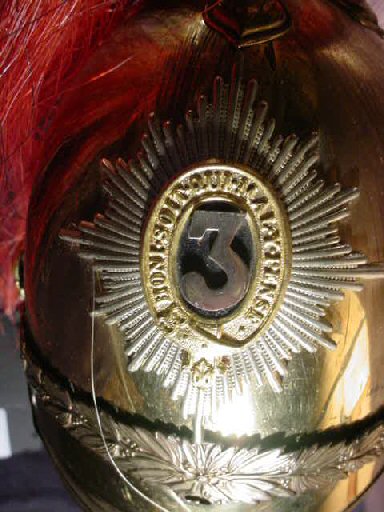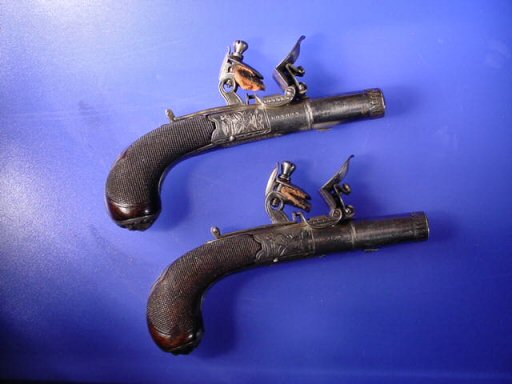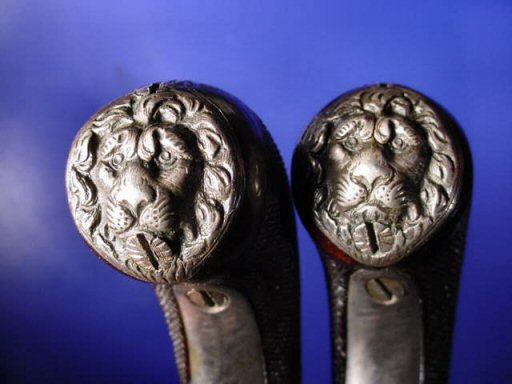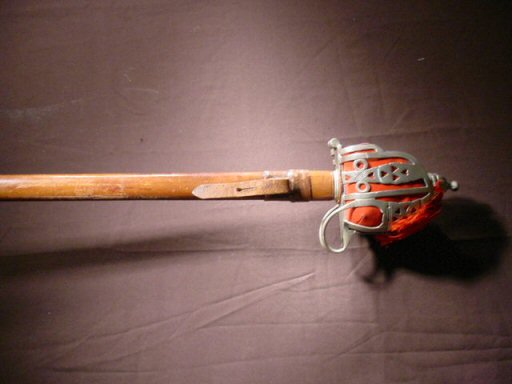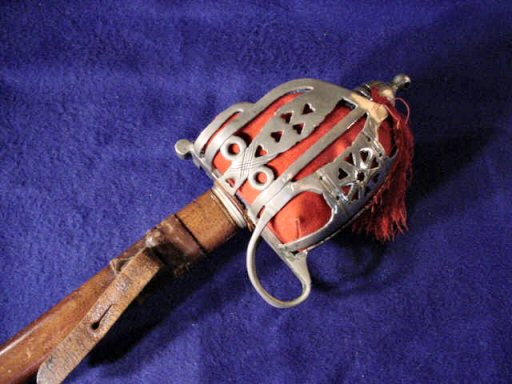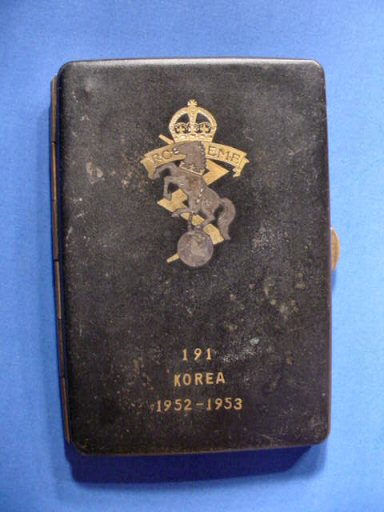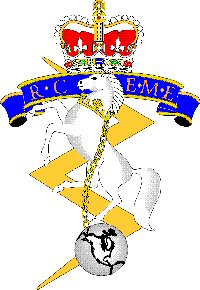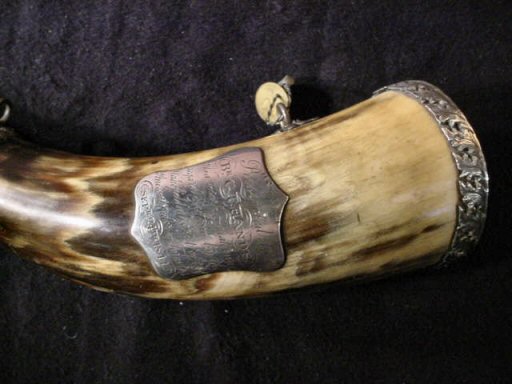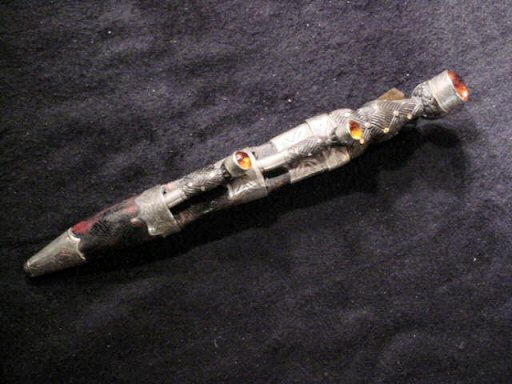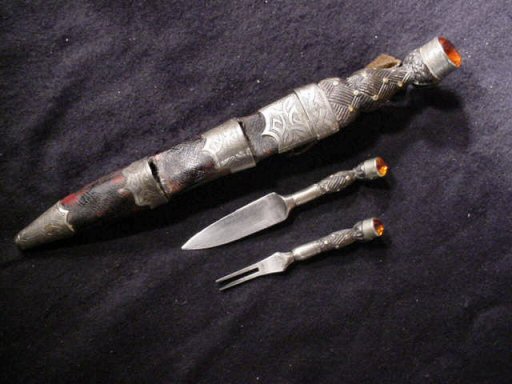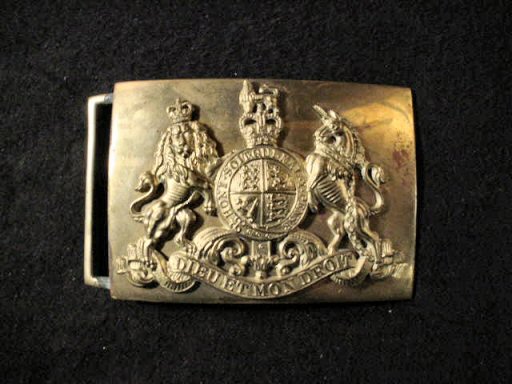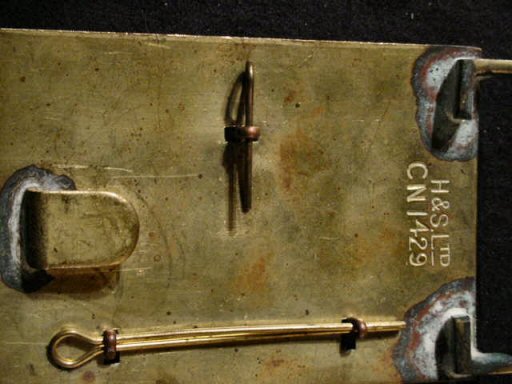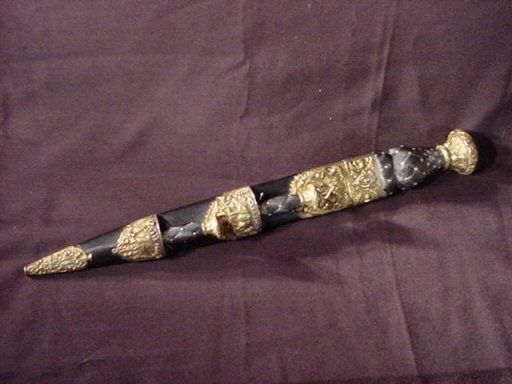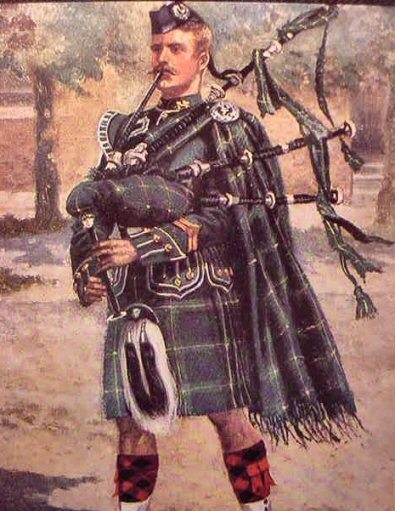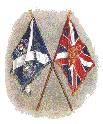|
|
|
|
Britain and Scotland
Page 2
|
|
|
|
|
|||||||||||||||||||
Scottish Sword and Shield from the Battle of Culloden (Item BRITSCOT 2-1) |
|||||||||||||||||||
| DESCRIPTION: Here is our pride and joy; a genuine mid-18th-century Scottish broadsword and targe said to have experienced the Battle of Culloden Moor on April 16, 1746. It was the final clash between the Jacobites and the Hannovarians as a result of the 1745 Jacobite rising. It was the last battle to be fought on mainland Britain and brought down the Jacobite cause that was to restore the House of Stuart to the throne of Great Britain. It was a decisive defeat from which it never recovered. The Jacobites, most of them highland Scots, supported the claim of Charles Edward Stuart, aka, Bonnie Prince Charlie or the young pretender the throne, the British army under the duke of Cumberland younger son of the Hanovarian sovereign, King George II supported his father’s cause. He was known as The Wee German Lairdy. The aftermath of the battle was brutal and earned the victorious general the name “butcher” Cumberland. The Bonnie Prince eventually left Britain and went to Rome, never to attempt to take the throne again, civil penalties were also severe, new laws placed by the world’s most historically arrogant and tyrannical and imperialistic nation now dismantled the highlander feudal clan system, and even highland dress was outlawed. We hope that this pair of Scottish weaponry was at least used at the earlier Battle of Prestonpans where the highlanders defeated the royal army. As I am of fiery Scottish blood and heritage I hope that the stains and rusting along the edges of the sword are not from water! Before Culloden there were many Scottish victories by the highlanders of the prince’s army, and we somehow feel that this sword and targe were at the center of them all. The items were part of an old British estate and after the death of an English lord of the manor the items (thankfully kept together) were sold at auction. They had graced the walls of the castle-like mansion for more than 200 years and the old man often stated that they were passed down through the family originating with the war trophies of General Sir George Wade, a notable military commander who figured into the suppression and defeat of the Jacobites. The items have been inspected by experts in the field and the age and style have been authenticated. The sword is in great condition considering its age. The basket hilt is typically iron and the style is termed ‘Claidheamh mňr,’ the Gaelic name for the Scottish claymore sword. The hilt, Scottish for sure, is probably early 18th century. The blade possible German and cold be late 7th century. It has a large domed pommel with a step for the end of the guard’s. The basket is of the fully developed highland type with stout bars of circular section. The piercing includes ‘hearts.’ The pommel and tang button are typical of the mid-19th-century swords carried by highlanders. The side guard is quite open with two iron bars twisted to look like backward S’s. Historians have often ventured the opinion that this configuration represented the ‘S’ for the House of Stuart (the bonnie prince’s family). We rather hold to this theory. The blade shows some of a centuries-old engraving employing a floral design and what looks like standard finials. This is typically German and this is understandable as the Scottish sword smiths of that era often traded with Solingen makers as the German and the Italian smiths were producing the best of blades. The basket hilts were invariably produced in the Glasgow and Edenburough areas. The leather grip within the basket is in wonderful condition. The blade is as it would be after usage and age. It is with double fuller which runs actually the whole length of the blade. The tip is blunted probably having been reshaped more than once. “The rib bones of these sassenachs are often rigid!” …broke many a point! The word targe had no meaning to us until the 17th century when it signified the shield carried by highland fighting men. Targes are circular and around 20 inches in diameter and are generally very strongly constructed of oak or pine. Two layers of wood are laid across each other for strength and covered with cowhide. The surface of the usual targe has designs tooled into it in panels of varying shapes which are outlined and emphasized by brass-headed studs of different sizes. There is almost always a central boss which sometimes pierced to employ a spike. The backing is most commonly cow, calf, goat, or deerskin. The back of the targe would have a leather arm strap or loop, a hand grip and straps by which it was slung on the back when not in use. The targe offered here is one of the cowhide-covered versions with the backing possibly also in deer hide or continued cowhide. It doesn’t have the spike boss, but otherwise pretty much fits the description of the typical 18th century type as enumerated above. This again is absolutely genuine and certainly matches the age of the sword. These two Scottish antiquities have been together since the mid 1700s and it would now be a shame to break them up. Only in museums today would one find such magnificent relics of Scotland’s glory, her victories, her defeat, and her resurrection. The book that we have borrowed much of our information and pictures from is titled The Swords and the Sorrows, and was published by the national trusts for Scotland.
PRICE: SOLD |
|
|||||||||
Scottish Basket-Hilted Broadsword (Claidheamh cuil) (Item BRITSCOT 2-1a) |
|||||||||
| DESCRIPTION: The hilt of this one is Scottish (sterling style), second quarter of the 18th century. The blade (unusually broad) is probably German and most likely contemporary with the hilt. The hilt is of iron and the pommel domed as was the fashion of these better swords in the 1700s. The sharkskin-wrapped grip is probably a later improvement as the original would have been of leather. The piercing on the grip includes “hearts.” The straight, two-edged blade has three separate narrow fullers all starting about 2 inches down from the hilt. On the blade are several armorer’s proofs; one is recognizable as a half moon; another is a circle with some unrecognized letters inside. Proofs appear on both sides of the blade. The overall length is about 38 1/2 inches. Because of the absolute similarity in style and the exact length being equal, we believe that this sword was made by the same maker as the one shown as figure 1:16 in the book The Swords and the Sorrows, published in 1996 as a catalog of a display for the national trust for Scotland, the maker of the sword blade shown in the book. They attribute it to Hermann Keiser of Solingen, Germany. It is likely that Keiser made this unusually wide blade, as well. The length of the blade is 32 inches. This is the true fighting sword and this is evidenced by the honest patina on the blade. Let’s hope it’s from the blood of the English invaders before they went back to “Tae think again.” When one hefts this mighty weapon one cannot help but think of the words of William Wallace: “Aye, fight and you may die, run, and you'll live... at least for a while. And dying in your beds, many years from now, would you be willin' to trade all the days, from this day to that, for one chance, just one chance, to come back here and tell our enemies that they may take our lives, but they'll never take... our freedom!” I’m sure that he held a wee broadsword like this one when he delivered that famous speech. This is one of the best that we have ever encountered of these national treasures of bonny Scotland.
PRICE: SOLD |
|
|||||||||
Miniature Guard’s Helmet (Item BRITSCOT 2-2) |
|||||||||
| DESCRIPTION: Here is a great little desk piece that depicts in miniature a helmet of the Royal Palace Guards, Third Regiment. The helmet is wonderfully constructed in brass with great silver insignia. The plume is actually real horsehair as in the full-sized helmet. It has the leather-backed “ringlet” chinstrap and full, leather liner. The helmet is identical to the full-sized version. The reason for these helmets’ being produced was usually for military units and regiments to be able to present such a magnificent trophy to a beloved officer; even if he was a Brit.
PRICE: $750.00; SALE Special reduction to $475.00 |
|
||||||||||||||||||||||
|
Lilliputian Flintlock Pocket Pistols (Item BRITSCOT 2-3) |
||||||||||||||||||||||
| DESCRIPTION: Here is the most charming set of small gentleman’s pistols we have ever come across in any of the hundreds of museum and private collecting that we have encountered. Believe me, these little gems are superb in design and condition to have survived as a pair from the 18th century and speaks of the care that each successive owner had bestowed upon them through all these many years. They obviously have enjoyed the benefits of keen and purposeful stewardship. They are in almost perfect condition throughout. The pistols are by Tire-Buck? We know the last part is Buck, but not sure of the first part. They are, of course, smooth bored. The hidden trigger snaps down when the hammer is locked back. The barrels screw off for loading and cleaning. Click here to view an animation of loading and firing the pistol. Select "Table of Contents," then select "Survival Tools/Pocket Pistols" about halfway down the table of contents. There is a typical engraved scene of British military splendor at the side. These were commonly called “muff pistols” or pocket pistols, and often were carried by ladies as a defense. This pair, because of the military motif, more likely might be what a well-to-do-British officer of his/her majesty’s armed forces might own and carry. The martial lion face that appears on the end of each butt gives this impression. There is other fine engraving around the trigger, and at the snout of the barrels on the right side of the receiver is the clear mark “London.” The grips are finely chiseled and checkered British oak. The only damage that can be perceived is where the wooden grip touches the steel frame (pointed out in our images). There is a tiny chip missing. This occurs on one pistol only. There are mandatory armament marks forward of the trigger bed. There is an ingenious safety catch behind the lock that secures the hammer when pushed forward. Its length is about 5 1/2 inches. Barrels when unscrewed are 1 1/2 inches long. We can’t say enough about these fantastic and extremely rare pieces. They are truly gems of the gun-collector’s world. Remember they are a pair and that is very unusual to find in even the most famous collections. This is a great investment for the serious collector.
PRICE: $5,300.00 |
|
|||||||
Scottish Broadsword (Claymore) (Item BRITSCOT 2-4) |
|||||||
| DESCRIPTION: This was the personal weapon and dress claymore of T.S. Crawford, who saw service in the famed London Scottish Regiment in WWI. It’s the classic example of this, one of the most famous swords of all time. This is in excellent condition and a good, sound, practically pristine example. It has the George VI crown and the Scottish thistles on its beautiful blade. Also seen are the British Isles arms with its motto: “Honi soit qui mal y pense,” meaning “Shame to he who thinks evil of it.” This superb basket hilt is as nice a one as we have ever seen. It has the traditional basket liner and sharkskin-wrapped grip. No maker’s mark is evident. This usually means that the regiment did not want to show any preference to any of the various companies, but “as fine a wee sword that it tis.” We have to assume that it is a product of none other than the famous Wilkinson Sword Company. So here is a bonny blade to wear when you next attend the Edinboro tattoo, or to cut the haggis with on Robbie Burns’ night.
PRICE: $1,500.00; the best |
|
|||||
Canadian RCEME Regt. Cigarette Box, Korea 1952-1953 (Item BRITSCOT 2-5) |
|||||
| DESCRIPTION: Here is a nice Canadian cigarette box decorated with the horse logo of the corps. It is a memento of the Korean War and a soldier’s service in 1952 and 1953. The logo seems to be in genuine gold inlay. The closure is nice and tight. There is a number ‘191’ above the word ‘Korea.’ Why? Also, there is a tiny gold insert inside with the characters ‘K24,’ again, why? The letters ‘RCEME’ stand for Royal Canadian Electrical and Mechanical Engineers. The case measures 5 x 3 1/2 inches. The holding strap for the coffin nails is missing inside. This is a nice item of the Korean War and has historic significance.
PRICE: SOLD |
|
||||||||||
|
Presentation Scottish Powder Horn (Item BRITSCOT 2-6) |
||||||||||
| DESCRIPTION: This museum gem is an extremely fine Scottish powder horn all elegantly embellished in sterling-silver appurtenances. It has a silver plate affixed that reads: “Presented to Br. G.T. Hand S. as a mark of fraternal regard & esteem by the Wakefield District of the Ancient Order of Foresters. Sepr. 24th 1844. The horn measures about 12 inches taking into consideration the curve. It is capped with a silver top plate with thistle design in the finest of relief and in its center is the full thistle of bonnie Scotland. The other end is capped with a silver tip on which a thistle crown is seen. On a horn such as this, that part functions as the feeding portal for loading powder into a weapon. In this case it is only decorative, but it bears an early class Cairn stone in the traditional manner. On the horn itself are two mounted rings that would be where the chain or leather strap would be attached. On the one at the front portion is a sealed tag in lead with a brass plate bearing a number ‘61.’ This is a museum inventory control tag. Evidently this piece was well thought of and considered historically important by a museum collection where it once reposed.
PRICE: SOLD |
|
||||||||||
|
Child’s Skein Dubh (black dirk) (Item BRITSCOT 2-7; SCOTWEAPON 1-7) |
||||||||||
| DESCRIPTION: Here is a charming little lethal weapon as given to a trusted minor. It’s just a nice little dirk in miniaturized size. Other than that it’s an exact duplicate of a full-sized Scottish dirk. It has all the Celtic engraving on the various parts and genuine Cairn stones (agate) in the main dirk and in the hilts of the small knife and fork. At best guesstimate we would say that this piece dates from the 1880s or 1890s. It has the leather carry strap and the leather-covered scabbard is scuffed a bit, but is all intact. It has the traditional serrated blade. The overall length is about 9 3/4 inches. The blade is about 5 3/4 inches long. This is an unusual child’s dirk in that it even has a blade. Usually these had no blade at all and were simply a decorative accoutrement to a child’s highland outfit. This one, however, being 100-percent complete indicates that the child was trusted and under a strict discipline known usually in the landed gentry or royal families of Scotland. This is a rare museum-worthy relic.
PRICE: SOLD |
|
||
|
Belt Buckle of Line Regiment of the British Army (Item BRITSCOT 2-8) |
||
| DESCRIPTION: This is an all-brass buckle with the separately affixed British coat of arms of the empire. This probably dates in the pre-WWI era. This is a belt buckle for a dress parade outfit. It’s a large piece measuring 4 x 2 1/2 niches. On the back is the company stamp ‘H&S Ltd CN 1429.’ The escutcheon on the front is held in place with the usual pin slide appurtenance. It’s in nice condition and fairly rare, today.
PRICE: $175.00 |
|
||||||||||||
|
Scottish Black Dirk (silver mounted) (Item BRITSCOT 2-9; SCOTWEAPON 1-8) |
||||||||||||
| DESCRIPTION: This is a fine, proud Scottish dirk of the piper variety. It is silver mounted, but bears no silver designation or hallmarks. In the military style it has the seal of Saint Andrew that seems to be expertly hand engraved and is flanked by two sprays of acacia branches. The letters ‘IBMN’ appear to be also done by hand on the facing of the silver pocket that accepts the small knife of the knife-fork set. On the facing of the fork compartment is ‘NIC.’ The length of the piece is 18 inches overall. The blade has the typical serrated edge running down three quarters of the length. The grip with hand-carved Celtic knots is also studded with silver pinions. This is just a superior dirk of the finest quality throughout. Circa: 1850.
PRICE: $3,250.00 |
|
||||||||||||||||||||||||||||||
|
Foot Dress Dirk of the 74th Highland Regiment (Item BRITSCOT 2-10; SCOTWEAPON 1-9) |
||||||||||||||||||||||||||||||
| DESCRIPTION: Here is one of the finest military dirks we have ever seen. It’s from one of the finest Scottish regiments that bonnie Scotland ever fielded. In 1881 it was formed as Highland light infantry. This elite regiment had the battle honors of SERINGAPATAN, ASSAYE, BUSAGO, FUENTES D’ONOR, CIUDAD RODRIGO, BADAJOS, SALAMANCA, VITTORIA, PYRENEES, NIVELLE, ORTHES, TOULOUSE, and PENINSULA all listed on its gorgeous blade. The regiment was formed in 1787 for service in India when war with the French was imminent. Its regiment badge, with the elephant subscripted beneath “Assaye,” was named for the Battle of Assaye in 1803. Wellington described it as the bloodiest of all battles fought. The 74th was one of the regiments given this coveted battle honor. This was the key battle of the Second Maratha War in India. The regimental motto—“NEMO ME IMMUNE LACESSIT,” “Nobody provokes me with impunity!”—is seen in relief in the band that encompasses the area where the grip meets the blade and again engraved on the blade itself. This was also the motto of the Order of the Thistle. The saying is also on the Scottish national coat of arms. A story in supreme heroism attends the saga of the 74th aboard the temporary military transport ship Birkenhead, which struck an uncharted rock off the South African coast while carrying British troops heading to fight in the Frontier War, a detachment of the 74th Highland Regiment was aboard. There were three lifeboats sending women and children to shore in three roundtrips. The term “women and children first’ was established during this evolution. This type of orderly evacuation is still known as the “Birkenhead Drill.” Only 193 people were saved. The men of the 74th, who were not required to organize the evacuation, calmly stood in formation as the deck of Birkenhead broke up beneath them. Along with these brave men stood the two regimental pipers who piped the tunes: “Flowers of the Forest,” “Scotland, the Brave,” and “Nearer my God to Three.” Most of them drowned; there were sharks. Full well, they earned their pay! The 74th was certainly one of the most glorious regiments of Scotland. The dirk is in beautiful condition throughout and it dates from the time of Queen Victoria, whose crown is seen at the top of the etching on the backside of the beautiful blade. One of the Cairngorm stones has been replaced. The one in the little fork inserted in the scabbard pocket but it is indeed a genuine Cairngorm stone (amethyst) replacement. The other amethyst stones are of the lavender coloration (very rare). The dirk measures about 17 1/4 inches long in its scabbard. The blade length is about 11 1/4 inches long. This is about the most handsome military dirk we have seen and in such practically mint condition. (Nay finer a wee dirk exists!)
PRICE: SOLD |
Page Two |
Please refer to item designator in parentheses in all correspondence.
Please E-mail for any additional information you may need.If you prefer, contact 'Germania' at PO Box 68, Lakemont, GA 30552
or call at 706.782.1668.
Please! do not call during the wee hours of the morning. The best time for calling us is between 9 and 11 am and between 9 and 11 pm eastern time.


